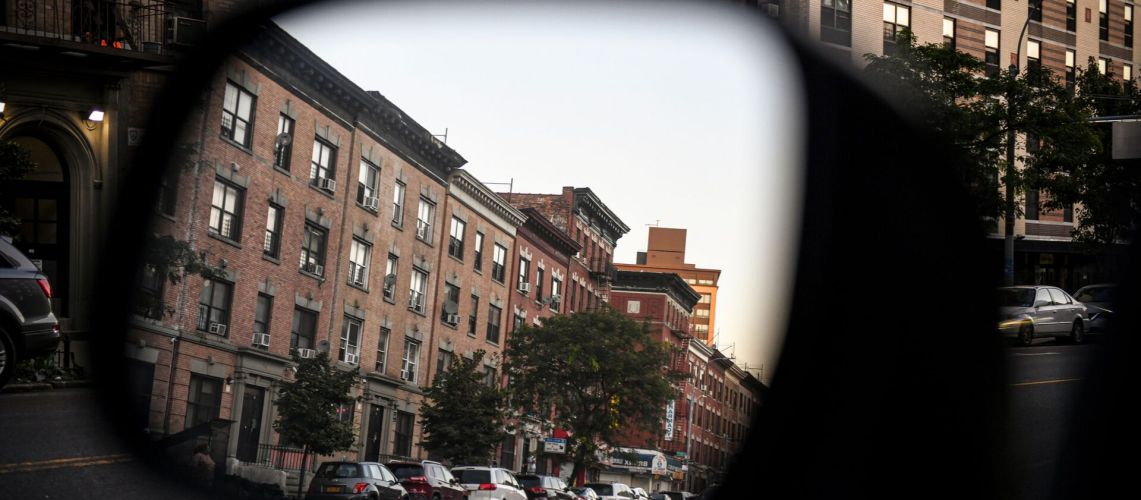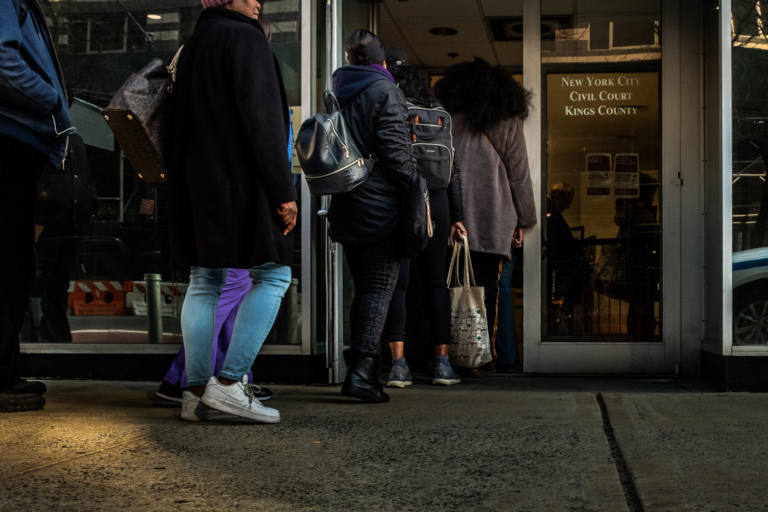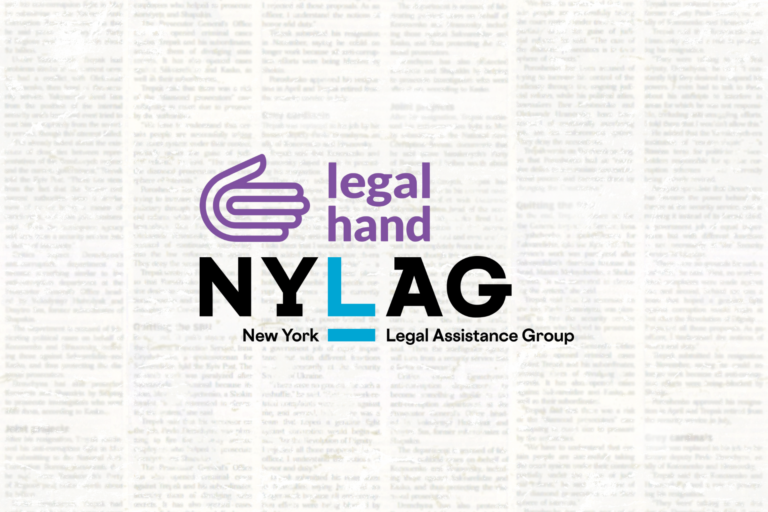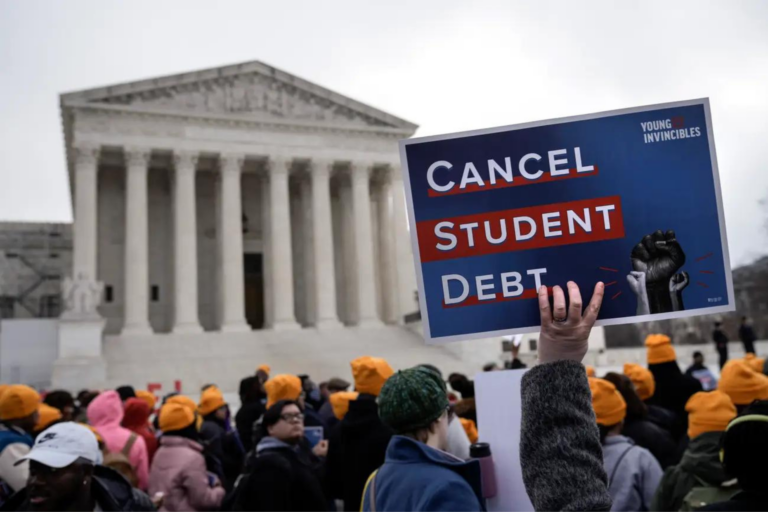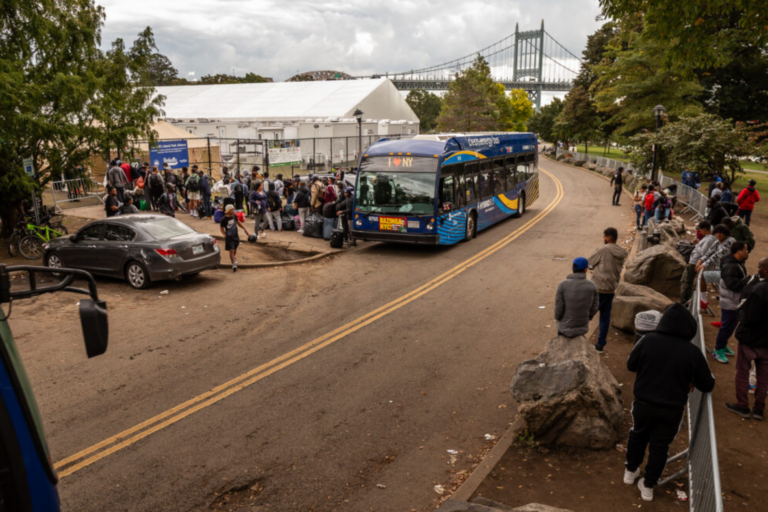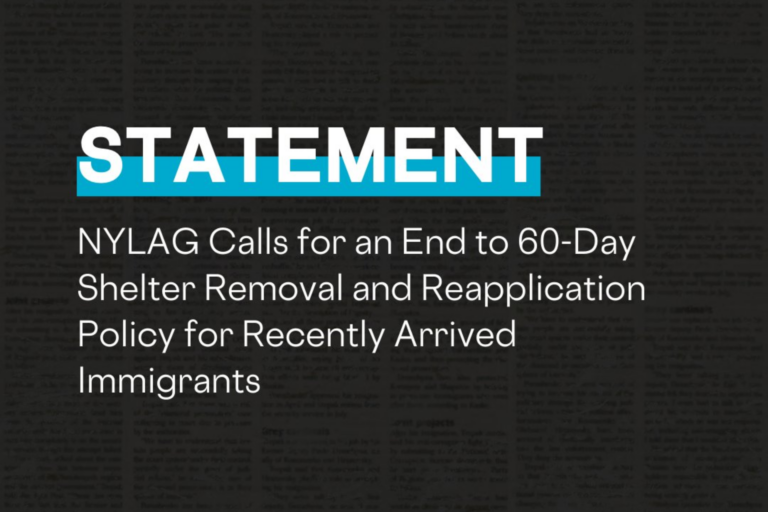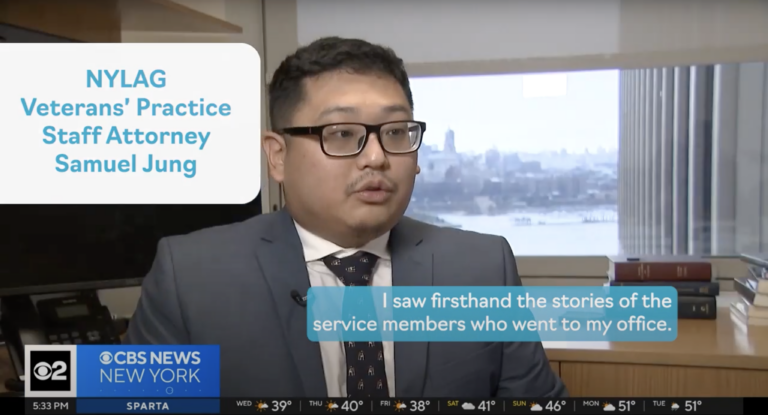Growing up black and undocumented in a heavily policed neighborhood is often a ticket to the prison-to-deportation pipeline.
Shamira Ibrahim
Vox
When public defender Sophia Gurulé tried to visit her client in ICE detention in June, she was hit with a roadblock: His facility in Bergen County, New Jersey, was under quarantine due to a mumps outbreak. She wouldn’t be able to talk to her client in person for the next three weeks.
For 25-year-old Ousman Darboe, daily communication with his legal representation is essential. In May, he lost his removal proceedings case in immigration court. Now, he is pending deportation to his birth country of Gambia.
While he was quarantined in a unit with little air ventilation in the middle of summer — his family a two-hour bus commute away in the Bronx — Gurulé has been fervently at work on an appeal. She is exploring all options, including sending a letter to New York Gov. Andrew Cuomo for his release. This is the final chance she has to help keep his family together. Darboe has never held his daughter, now 17 months old, outside of a detention facility.
Like many of the approximately 10.5 million undocumented immigrants living in the US, Darboe came to the country as a child. He was 6 years old when his parents brought him and his three older siblings to New York in 2001, settling in the Fordham Heights neighborhood of the Bronx, one of the poorest congressional districts in the country.
Navigating life in a strict Muslim home, where he helped care for his younger siblings, was occasionally at odds with his assimilation as a kid in Fordham Heights. But Darboe worked quickly to fit in. He shed his accent and learned English. He played basketball and often kept quiet. And, much to his family’s disapproval, he sometimes cut school, often to avoid the heavy violence and policing on campus.
:no_upscale()/cdn.vox-cdn.com/uploads/chorus_asset/file/19234608/IMG_0586.jpg)
Based on the color of his skin alone, it’s not a surprise that Darboe went on to face numerous interactions with law enforcement as a teenager and young adult — a series of stops, alleged misidentifications, and arrests that led him to be locked up in Bergen County.
According to the Bureau of Justice of Statistics, black and Latinx residents are more likely to be stopped by police than white residents, and when stopped, police are twice as likely to threaten or use force against them. According to the New York Civil Liberties Union, these statistics are even starker in New York City: Black and Latinx people were the targets of four out of every five reported stops between 2014 and 2017, and black and Latinx people were more likely to have force used against them.
But as many immigrant justice advocates will tell you, if being black makes you a police target, then being black and undocumented in a poor neighborhood will make you vulnerable to surveillance, punishment, and exile. Darboe wasn’t born of privileged social class or with means to a prestigious education; he did not fit the “exceptional immigrant” model preferred by US immigration policy. The odds of Darboe living not only a free life, but any life at all in this country, were stacked against him from the moment he stepped on US soil.
Darboe has instead found himself in what criminal justice reform activists call the prison-to-deportation pipeline, a coded system that works to funnel black and Latinx immigrants from the criminal court system into Immigration Customs and Enforcement (ICE) custody, to the immigration court system, and ultimately back to their nations of birth — with very little recourse or space for adjudication.
For example, low-level crimes such as marijuana possession are lumped into the offense of “drug trafficking” in immigration court — even if it’s recognized as a misdemeanor in the criminal courts — mandating automatic deportation without any leeway for a judge to consider an individual’s circumstances, according to Human Rights Watch. As a result of this one-size-fits-all policy, deportations over drug convictions of any sort increased 43 percent from 2007 to 2012.
Peel back the numbers further, and black immigrants make up a disproportionate amount of criminal-based deportations. According to the advocacy group Black Alliance for Just Immigration, which reviewed data on immigrants from African and Caribbean countries from the Department of Homeland Security Yearbook and the Transactional Records Access Clearinghouse, 76 percent of black immigrants are deported on criminal grounds, compared to 45 percent of all immigrants. Despite making up only 7.2 percent of the noncitizen population in the US, more than 20 percent of people facing deportation on criminal grounds are black.
“There’s a particular intersection of vulnerability — immigrants in general are vulnerable, and there’s often poverty and racial aspects to their vulnerability as well,” said Jodi Ziesemer, director of the Immigrant Protection Unit at the New York Legal Assistance Group, a nonprofit that provides comprehensive free legal services and advocacy. “Black and undocumented immigrants are at particular risk because they’re targeted racially by a lot of our institutions … while being also targeted for ICE and enforcement actions.”
As a young quiet kid, Darboe would have never guessed that his existence in the US — and in the Bronx in particular — would put him on a trajectory of altercations with law enforcement, eventual incarceration, and possible deportation. Darboe’s sister Adama said her brother once told her, “I came to this country thinking it would be better for me, but they’re actually against me.”
:no_upscale()/cdn.vox-cdn.com/uploads/chorus_asset/file/19235370/DesireeRios_DarboeEdits_042.jpg)
A path that began with police targeting
Darboe’s first interaction with police came at age 16: On June 25, 2010, he was falsely accused of stealing headphones at DeWitt Clinton High School in the Jerome Park neighborhood of the Bronx. Situated just around the corner from the famed specialized high school Bronx High School of Science, DeWitt has a history of police patrolling the hallways and metal detectors that caused hour-long delays, a system that left students feeling “like inmates,” according to a 2005 New York Times report. It was a situation so toxic that more than 1,500 students marched over to the Department of Education at the beginning of the school year.
When Darboe was at the school five years later, not much had changed. He told the court earlier this year that there were a lot of gang wars, fights, and cuttings. “DeWitt Clinton was a harsh place to go to school, because most of the time there’s gang wars — there’s weapons being found at school,” Darboe testified. “Basically nobody went to class.” Gurulé says Darboe witnessed police being given free rein to stroll the school, on top of the standard school security that already existed on campus. (DeWitt Clinton High School has not responded to Vox’s request for comment).
:no_upscale()/cdn.vox-cdn.com/uploads/chorus_asset/file/19235387/DesireeRios_DarboeEdits_003.jpg)
His eldest sister, Adama, in contrast, went to Marble Hill High School for International Studies, a smaller school with an above-average reputation and an emphasis on dedicating resources to college preparation. Adama tells Vox these schooling differences significantly impacted the siblings’ trajectories, placing Darboe in an environment that put him under police scrutiny, and with a friend group that grew accustomed to being viewed as criminals.
Though Darboe was quickly found not to have stolen the headphones and his case was dismissed, the incident would prove to be the first in a long string of interactions with police. According to court documents, Darboe said that while the kids in Fordham Heights were “not the best of influences,” they would often be “attacked by the police officers” because the neighborhood was simply known to be violent.
“Broken windows” policing was common in neighborhoods with large black and Latinx immigrant populations such as Darboe’s area of the Bronx. By focusing on low-level crimes in so-called unkempt neighborhoods — with vandalism, loitering, and drug offenses — police departments theorized they could prevent bigger crimes from happening there. In the 1990s, police in cities like New York took this practice one step further and instead of waiting for people to commit misdemeanors, they enacted “stop-and-frisk” — stopping, questioning, and frisking anyone who looked suspicious.
According to a 2013 study by the Vera Institute of Justice, at least half of all recorded stops by police in New York City involved people between the ages of 13 and 25, and more than 40 percent of young people who’ve been stopped said they have been stopped nine times or more — with nearly half reporting that threats or physical violence were used against them. Broken windows and stop-and-frisk policing created an environment where kids from certain neighborhoods, and often of a certain skin color, were repeatedly profiled as criminals. In fact, in 2013, a US district judge in New York ruled stop-and-frisk unconstitutional and ordered police to stop the practice in the Bronx specifically, because of the way it targeted young black and Latinx men.
But that ruling — which outlawed stop-and-frisk but didn’t put an end to broken windows policing — came several years after Darboe was already caught up in the system.
In October 2010, four months after being falsely accused of stealing the headphones, Darboe was fingered for stealing a purse and was adjudicated as a youthful offender. When asked in court why he stole it, Darboe said that he didn’t have any school supplies, or a book bag, and he couldn’t ask his parents because he knew they didn’t have the money. “I felt, I felt bad because I felt like I had to take [a] drastic measure to get the stuff that I needed,” he said.
Three months later, in the following January, he was stopped and frisked on Webster Avenue — just down the block from his childhood home — and charged with marijuana possession, but was only found guilty of disorderly conduct. And in March 2012, he was charged for cellphone theft, which landed him in Rikers Island — a jail complex infamous for its excessive use of violence in inmate discipline — as a violation of his previous youthful offender agreement over the purse theft.
During his time at Rikers, having just turned 18 and awaiting his cellphone theft hearing, Darboe spent nearly 10 months total in solitary confinement for fighting, and five of those months he says he was not even aware he was able to step outside for an hour a day and get fresh air.
When he was finally sentenced in July 2013, Darboe was sent to Greene Correctional Facility in upstate New York to serve time for both petty theft charges; nine months later, he was released on parole — meaning that he spent more time in pre-trial detention awaiting his sentencing than his actual sentence. His disappearance was so abrupt that his longtime friend from high school, Lashalle Poston, now his wife, initially thought he had left the city. “At first I thought, African parents, when they get in trouble, they send their kids to Africa,” Poston tells Vox. “He just disappeared.”
:no_upscale()/cdn.vox-cdn.com/uploads/chorus_asset/file/19235847/DesireeRios_DarboeEdits_032.jpg)
:no_upscale()/cdn.vox-cdn.com/uploads/chorus_asset/file/19235848/DesireeRios_DarboeEdits_023.jpg)
Despite having spent the latter half of his teen years being in and out of facilities, a youth offender record is not a criminal record; it is automatically sealed and does not have to be reported as a criminal conviction. “It wouldn’t bar him from applying for things,” Gurulé said, referring to documentation that wouldn’t leave him vulnerable to deportation. “A judge can be, ‘I see you got arrested for doing that and I don’t like that, that makes me think you’re a bad person,’ but it doesn’t bar him for applying.”
So upon his release in 2014, at age 20, Darboe took steps to make a fresh start. He moved back in with his parents; started dating Poston, who served as his support system during his incarceration; and began attending Getting Out and Staying Out, a Rikers reentry program for young adult men.
But despite his best intentions, staying out would prove to be not so easy.
The pipeline from juvenile to immigration court
In September 2014, less than six months after Darboe’s release, a neighbor in his parents’ building was walking when she had her gold chains robbed from her neck. Given that he was recently paroled, Darboe was identified as a person of interest by the NYPD. Darboe says on the day of the incident he was at Getting Out and Staying Out (the organization was only able to confirm his regular participation but not his specific whereabouts that day, according to court documents).
When police searched his belongings, they were unable to find any items that tied him to the description given by the neighbor. However, the victim identified him in a police lineup, both recognizing him as a resident in the building and perceiving him to be the assailant: “She thinks that he did it because it was a ‘big black man,’” Adama says, “and [that’s who] Ousman was.”
Darboe was charged with multiple offenses — three counts of robbery plus assault, criminal possession of stolen property, and harassment. He was now considered an adult. At his arraignment, he entered an initial plea of not guilty and was released on bail after 60 days.
But his release was turbulent: He had multiple police interactions for a variety of unrelated charges, such as gun possession and possession of a false check, both of which were dismissed (they were committed by an associate of his, according to court documents). He then landed back in Rikers because the robbery charges were a violation of his parole. While in jail, he was accused of illegally possessing a razor, an offense of which he was acquitted.
Worn down from being in and out of detainment and solitary confinement — and fearful that the NYPD, in its persistence to obtain evidence, would generate a second witness willing to corroborate the alleged robbery story to better their own circumstances — Darboe made an about-face in February 2017 and took a plea deal of one count of felony robbery for time served. According to court documents, Darboe said he took the deal because he was disappointed in himself — not because he had committed the crime, which he maintains he did not, but because of his past. “I had to blame myself for my previous cases, because if I would have never caught [charges in] those previous robberies, I would have never been a target for [the gold chains] robbery.”
While pleading under duress is a common scenario for black men with extended stays in pre-trial detention, doing so has significant implications for immigrants.
Five months later, Darboe was at his parents’ apartment in their new Bronx neighborhood of Kingsbridge when ICE knocked on the door. Even though his recent case dismissals meant he was supposedly no longer under threat of incarceration, ICE officers gained entry to the apartment saying they were police, under the pretense of having a warrant for someone else in the neighborhood, says Gurulé. This tactic is reportedly used by some agents to get immigrants to let them in a residence: ICE officers announce that they’re law enforcement and that they have a “warrant,” even though the warrant is only administrative and not signed by a judge.
Once inside, agents proceed to make arrests after they validate that the person in the home is the same person who may be already flagged on their watchlist as a target, with a particular emphasis on undocumented persons. (ICE has not responded to Vox’s request for comment on its arrest or warrant process, or Darboe specifically, but an ICE spokesman denied to Documented in 2018 that they pose as local law enforcement; however, he said ICE “may use the universally recognized ‘POLICE’ when initially making contact with someone during a field operation.”)
:no_upscale()/cdn.vox-cdn.com/uploads/chorus_asset/file/19235932/DesireeRios_DarboeEdits_048.jpg)
This is the kind of tactic advocates and lawyers warned immigrants to guard against during the recent ICE raids announced by the Trump administration. But Darboe didn’t know that the warrant wasn’t signed by a judge, and that he was thus protected by the Fourth Amendment from having to open the door. He was quickly taken away by ICE agents to the Hudson County Detention Center in New Jersey.
Darboe was detained on July 31, 2017 — the same day he was scheduled to have his forged check charge dismissed. A handful of days later, his girlfriend Poston discovered she was pregnant with their first child — a girl, Sanai, to be born the following April. She wouldn’t be able to visit Darboe for four months.
Outside of transferring facilities to Bergen County, Darboe has not left ICE custody since July 2017, having been denied bond after an extended delay due to “dangerousness,” according to a judge in the NYC immigration court. This is despite having only one adult conviction and significant roots in the city: He has eight siblings and parents who, at this point, are all legal permanent residents or have birthright citizenship. He also married Poston in Hudson County Detention in December 2017.
Poston’s initial I-130 petition, the first step to authenticate and establish a record of marriage in the visa application process, was denied by the United States Citizen and Immigration Services (USCIS), stating that the couple did not have joint assets such as property or bank accounts, and therefore the marriage was possibly fraudulent. (When asked for comment, USCIS told Vox it doesn’t comment on specific cases.)
“They tried to tell me that we didn’t submit enough evidence, that my relationship wasn’t real,” Poston tells Vox. “Me pushing out a kid in labor for 29 hours wasn’t enough?”
While the decision was ultimately overturned on appeal, Gurulé points out that the logic behind the authentication is classist. She notes that in tandem with ICE, the USCIS “has become a form of law enforcement in their own way,” expanding from an organization intended to manage benefits and services for immigrants to an investigation service of its own.
The delays in the spousal visa process extended Darboe’s detention by ICE for another year. In the meantime, Poston has navigated pregnancy and early motherhood alone.
Laws make the case for the “exceptional immigrant” — but don’t account for the systemic hardships immigrants face
In 1996, the Clinton administration signed into law two key pieces of legislation: the Antiterrorism and Effective Death Penalty Act and the Illegal Immigration Reform and Immigrant Responsibility Act, which both served to retroactively tie immigration status to criminalization. Congress expanded what fell under its “aggravated felonies” classification when it came to deportable offenses, and standard deportation protocol could now be circumvented for “fast-track” removal proceedings. (Under the Trump administration, for example, an undocumented immigrant who cannot prove over two years of residency is eligible for “fast-track” proceedings.)
Deportable offenses — previously, murder, drugs, and firearms trafficking — now included nonviolent felonies and misdemeanors, such as theft, filing a false tax return, illegal entry in and of itself, or failing to appear in court. During the Bush administration, the largest increases in deportations were of undocumented immigrants convicted of traffic violations: 43,000 total during his last five years in office.
Even in the Obama era, immigration detention and deportations rates continued to rise astronomically: From 2009 to 2015, the administration engaged in over 1 million “interior” removals — excluding those who were apprehended while attempting to cross the border — a rate that was nearly double that of the prior administration. According to a New York Times’ analysis of internal government records, two-thirds of the deportation cases during the Obama administration involved immigrants who were either convicted of minor infractions or had not yet been convicted of a crime.
Obama also played into the “good vs. bad immigrant” schism that has helped fuel hostility toward immigrants in this country: His infamous “Felons, not Families” speech kicking off the Deferred Action for Parents of Americans program failed to reconcile immigration policy with the systemic surveilling and incarceration issues that plague people of color; he implied there is no scenario in which a person selected for deportation could be both a felon and part of a family.
:no_upscale()/cdn.vox-cdn.com/uploads/chorus_asset/file/19236097/GettyImages_462749486.jpg)
The “exceptional immigrant” paradigm was further reinforced by immigration reform that only emphasized pathways to citizenship for young immigrants who exhibit “good moral character.” Policies like the Deferred Action for Childhood Arrivals established a temporary deferred status via a rubric that is difficult for many young immigrants to meet: The college-bound DREAMer, or undocumented immigrant in the armed services with a spotless police record, doesn’t represent the lived reality of many young immigrants. According to the United States Department of Education, 54 percent of undocumented youth earn a high school diploma, and only 5 to 10 percent of undocumented high school graduates enroll in a higher education institution — far fewer successfully graduate with a degree.
“A spotlight on ‘exceptional’ black immigrants often erases and makes invisible the lived experience of black immigrants who experience police brutality, state surveillance, poverty, and workplace discrimination, among other things,” says Nekessa Opoti, a communications strategist at the UndocuBlack Network, an advocacy organization comprised of black immigrants.
:no_upscale()/cdn.vox-cdn.com/uploads/chorus_asset/file/19236117/GettyImages_502928324.jpg)
This is a plight that Darboe knows very well: He was not a perfect student. His case does not make for an exceptional immigrant soundbite. It’s easy to look at Darboe’s rap sheet and dismiss him as someone who has continually erred, particularly as a teen, and is therefore not entitled to sympathy.
This is the fundamental shortcoming of the emphasis on “model minority” narratives: They lack space for the acceptance of a world in which an immigrant lived a “regular” life, especially one that’s subject to heavy police surveillance. Attending an over-policed high school where students were constantly under suspicion, living in a neighborhood where the color of his skin was enough for police to stop him, Darboe had little chance of being seen as a model citizen.
He certainly wouldn’t be given much of a chance to grow up and turn his life around; he wouldn’t even be seen as worthy of such an opportunity.
His daughter, he said in immigration court earlier this year, “helps me feel that I got something to fight for, that I got something to go to, that … I really got to stop doing what I was doing my previous years as a teenager. Now I got to mature, not only for me, but only to be a better example for my daughter.”
Darboe’s youthful offenses — pilfering a cellphone and a purse as a teenager — are far from the actions of MS-13 villains trotted out by the Trump administration to justify strict immigration policy. But such indiscretions are much more common reasons for being removed from this country than any salacious violence.
Even sanctuary cities are limited in protecting immigrants from ICE
Even when there are laws in place to ostensibly help immigrants understand the criminal court process, they can fail. In 2010, the Supreme Court ruled in Padilla v. Kentucky that criminal defenders must ask their clients about their immigration status so they can inform them of the possible deportation consequences of a guilty plea before sentencing.
“That should happen,” Ziesemer says. But because courts are often backed up and public defenders often have massive caseloads, “I think there’s a lot of pressure on both ends that make that not a perfect system and … are not super protective of due process rights,” she says.
This gap in due process even happens in places like New York City, which have reputations as “sanctuary cities” and are supposed to limit their cooperation with ICE. But as the Intercept reports, ICE has evaded sanctuary rules by using NYPD fingerprint records to send letters to immigrants arrested — usually for low-level misdemeanor offenses — asking them to come into the agency’s Manhattan offices. In the cases of two immigrants who complied and went down to the office — neither of whom had open removal orders against them or criminal convictions — both were detained.
As explained by Albert Saint Jean, the New York organizer for Black Alliance for Just Immigration, no matter how noncompliant a city administration vows to be, broken windows policing serves as a feeder system for ICE.
“If you’re doing heavy policing in black neighborhoods in NYC, guess what? Undocumented people live in those neighborhoods too. When you’re policing heavily black and brown communities, that’s where the bulk of our immigrant community and undocumented community live. So in essence, every time these people get fingerprinted, every time these things happen … ICE gets notified.”
:no_upscale()/cdn.vox-cdn.com/uploads/chorus_asset/file/19236209/GettyImages_645589052.jpg)
Subway fare evasion is one of the top reasons that both Ziesemer and Saint Jean say their New York clients have been flagged for immigration purposes. In 2018, 90 percent of those arrested for this crime were reported to be people of color. This will only continue with Gov. Cuomo’s announced plan to expand the police force dedicated to fare evasion from 30 cops at 15 key New York City stations to 500 officers across 100 stations and bus stops.
Ziesemer says she has a client who is Garifuna from Honduras who got ticketed for having an open container in the Bronx. “If he wasn’t an immigrant, he would have paid a small fine and that would have been the end of it,” she says. “But because that got routed into the immigration system, he got picked up and has been detained for over six months.”
Detained immigrants have little recourse against deportation
When immigrants are detained, Ziesemer says, “there’s no obligation for ICE to bring them in front of a court, for them to seek bond. There’s no appointed attorney, there’s very little recourse to getting out of detention on a sort of pre-trial basis.” It’s called “civil detention,” she says, “but in reality, these people in Bergen County and all these other jails, they’re literally housed alongside people who have been convicted of crimes. Immigrants really do fall down a black hole when they’re detained.”
Some detained immigrants are allowed video testimony, which still isn’t standing before a judge and advocating for their own character. This has increasingly become the default for immigration courts around the country, according to Gurulé, and organizations have been suing over the violation of people’s due process.
:no_upscale()/cdn.vox-cdn.com/uploads/chorus_asset/file/19236296/AP_17043509687891.jpg)
One exception to the “black hole” norm was the high-profile detention of black immigrant 21 Savage — born Shéyaa Bin Abraham-Joseph — in February. The rapper was detained by Atlanta ICE agents days after criticizing the agency on The Tonight Show. While ICE claimed Savage was an “unlawfully present United Kingdom national” who came to the US as a teen and overstayed his visa, he had been living in Atlanta since he was seven. The incident was a shocking moment for many people, highlighting the power of ICE, and disrupting the image for many of what an undocumented immigrant could look like — black and famous.
Fortunately for 21 Savage, he had hefty legal support and the backing of Jay-Z to help prevent being buried in ICE’s system. However, most black immigrants do not have access to the resources afforded to celebrities. In Darboe’s case, his access to legal representation was courtesy of a New York City Council-funded initiative to protect low-income immigrants facing deportation called the New York Immigrant Family Unity Project, of which Gurulé’s firm, the Bronx Defenders, is a part.
“I would say more than half the asylum cases that I’ve gone for, they were people that you could see a pattern of police harassment,” says Saint Jean of his work as an organizer for Black Alliance for Just Immigration in NYC. “And the judges don’t look at it from that context. They look at it as ‘this person is a troublemaker.’”
Countless immigration activists do the work of trying to place these clients with proper legal representation, which can sometimes feel nearly impossible, with lawyers wanting to get nowhere near immigration cases that involve rap sheets. In Darboe’s case, when Poston testified that her husband had grown past his youth offenses, the prosecutor replied, “talk is cheap,” asking Poston, “What if he gets violent with you or your child?” even though Darboe has no record of violent offenses.
“[I think the judge] feels like, all black women go through that, and you’ll just be one more, and it’s fine … The system is helping you, you don’t need no other help from no man,” says Poston. “The system is actually not that goddamn easy.”
Poston has had to experience this firsthand. In the time that she has worked to advocate for her husband, obtaining Gurulé as his public defender, and attending all his necessary court dates, she temporarily lost a job and has settled into a shelter with their daughter.
:no_upscale()/cdn.vox-cdn.com/uploads/chorus_asset/file/19236363/DesireeRios_DarboeEdits_056.jpg)
“These judges see his kind of contact with the criminal legal system, and all reason and empathy flies out the door,” Gurulé says of her client Darboe. “No empathy, compassion, no sense of justice, nothing.”
If Darboe is deported, he will be excised from his community, family, and daughter, whom he may never see grow up. His emotional and mental health would also likely take a significant hit; deportees often suffer from depression and social isolation. Then there is Gambia, where the government is still working to stabilize society after a 20-year regime of human rights abuses left the country with high unemployment rates and in bankruptcy.
In the meantime, Darboe continues to wait. The mumps outbreak in Bergen County is over, and his appeal date is scheduled for October 3. He is relying on his Islamic faith to keep his spirit strong. He and his family know, though, that they must brace for the worst. After his two years in detention, they must come to terms with what has been the fate of many undocumented immigrants before him.
Originally published in Vox on September 30, 2019

